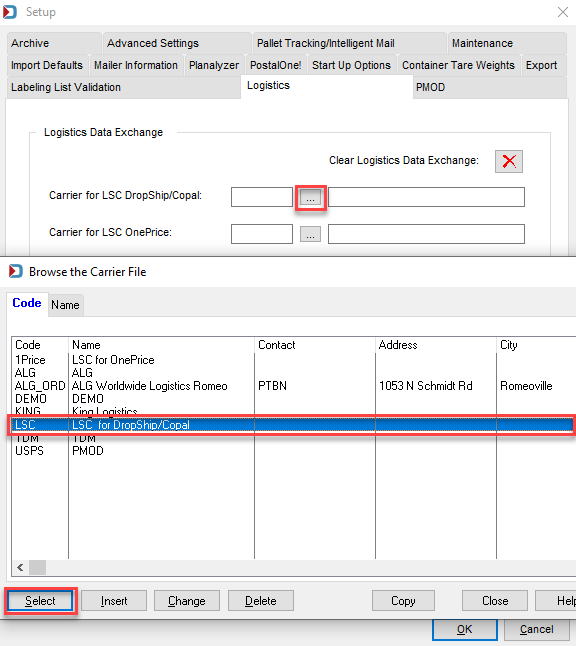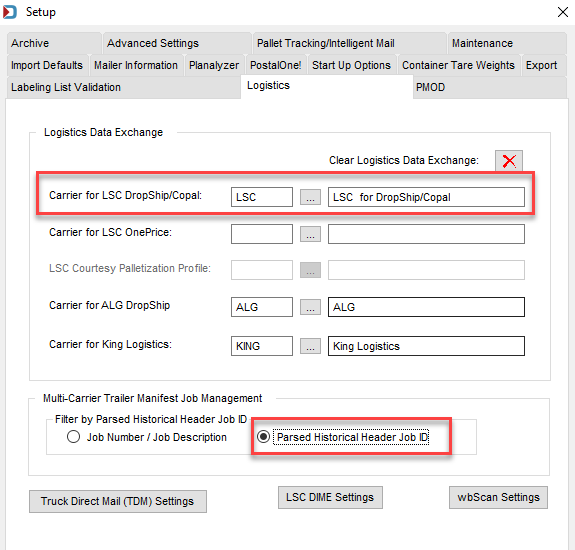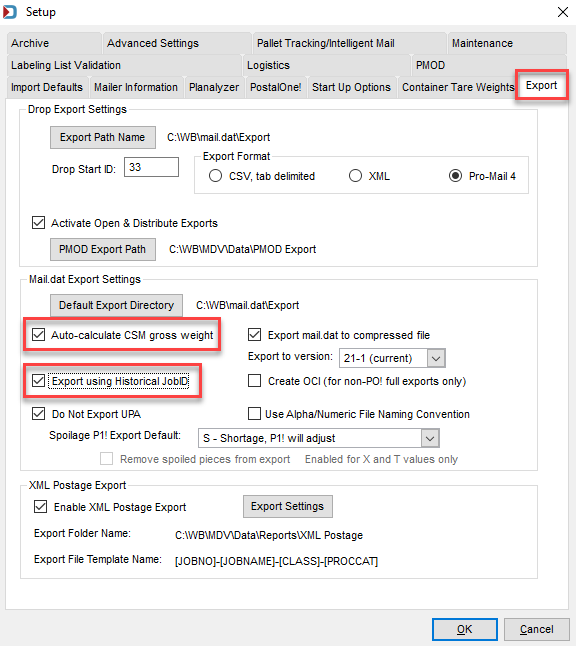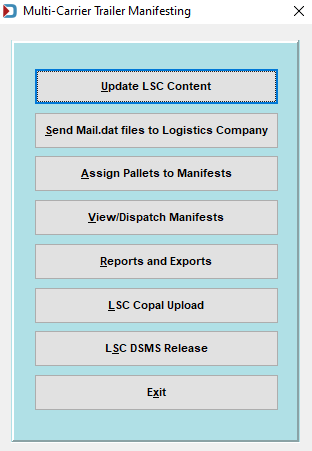LSC DropShip/Copal -DAT-MAIL Setup
This procedure assumes that LSC is already added as a carrier in the Carrier List.
There are additional settings for LSC DropShip/Copal to complete in DAT-MAIL after adding carrier information before you can begin using the MCTM function.
-
From DAT-MAIL’s main menu, select File > Program Settings > Program Setup.

-
Select the Logistics tab. Click the corresponding Browse for the Carrier for LSC DropShip/Copal field. From the Browse the Carrier File window, select LSC - LSC for Dropship/Copal.

-
The Browse for Carrier File screen will close, and the select carrier code and name will display in the Carrier for LSC DropShip/Copal field in the Logistics tab.
-
Under the Multi-Carrier Trailer Manifest Job Management section of the screen, select Parsed Historical Header Job ID.

The Parsed Historical Header Job ID option is where the first five characters of the Mailer’s historical header Job ID (the Job ID created by their presort program) represent a numeric Job ID. The last three characters represent a three-character ‘List ID’ or version.
The Parsed Historical Header Job ID option is required for all LSC users and those Mailers who use both LSC and non-LSC carriers.
-
Next, LSC site data must be entered to establish communication between DAT-MAIL and DIME for LSC DropShip/Copal users. To do this, click LSC DIME Settings.
Login credentials are Mailer-specific and provided by LSC.

-
The Transportation System Access screen will display. This screen contains the necessary information for connecting with LSC's DIME system.
Below the print screen is an explanation:

-
 Test Only. Do not access production database. checkbox: When using LSC DropShip/Copal in production, this option should be left unchecked. If using LSC DropShip/Copal in a test environment, select this option. New users can discuss this option with LSC.
Test Only. Do not access production database. checkbox: When using LSC DropShip/Copal in production, this option should be left unchecked. If using LSC DropShip/Copal in a test environment, select this option. New users can discuss this option with LSC.
-
 The information about the User ID, Site ID, and Password provided by LSC and not Window Book. Contact an LSC support representative to obtain this necessary information. Once LSC provides the information, enter it into the corresponding fields.
The information about the User ID, Site ID, and Password provided by LSC and not Window Book. Contact an LSC support representative to obtain this necessary information. Once LSC provides the information, enter it into the corresponding fields.The following site information (if not already present) must be entered/used to be able to communicate with LSC:
URL for Test Site:
http://dynamail.lsccom.com/dime/2.2.4/certification/dime.svc/basicText
URL for Production Site:
http://dynamail.lsccom.com/dime/2241/dime.svc/basicText
-
 Keep DIME Request Log records for: DIME Request Logs are records of the communication requests sent between DAT-MAIL and DIME. These log files are essential for troubleshooting purposes; however, the number of log files kept by the system can increase to the point where eventually, system performance could be affected. To combat this, you can set the number of days DAT-MAIL will retain the DIME Request logs. The system will purge anything older than the number of days selected. The default number of days to keep DIME Request Logs is 30.
Keep DIME Request Log records for: DIME Request Logs are records of the communication requests sent between DAT-MAIL and DIME. These log files are essential for troubleshooting purposes; however, the number of log files kept by the system can increase to the point where eventually, system performance could be affected. To combat this, you can set the number of days DAT-MAIL will retain the DIME Request logs. The system will purge anything older than the number of days selected. The default number of days to keep DIME Request Logs is 30.
-
Click OK to close the above screen.
-
Next, in the Setup screen, select the Export tab. Then, select the following checkboxes: Auto-calculate CSM gross weight and Export using Historical Job ID.
By selecting these export options, all Mail.dat files will be exported using corrected gross weight, and Historical Job ID replaces the system-generated Job ID (not just LSC DropShip/Copal exports).

-
And lastly, in the Setup screen, select the Pallet Tracking/Intelligent Mail tab. Next, select the Enable Pallet Tracking checkbox. This option will ensure that a 12-character Unique ID is generated, which is not the same as IMb. This option also allows for every job imported to have its pallets displayed in the MCTM system.

-
Finally, click OK to save the changes and close the Setup screen.
At this point, when the Multi-Carrier Trailer Manifesting option is selected from within the Logistics menu, the corresponding function buttons will appear in the navigator-style menu.

See also